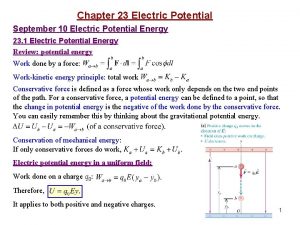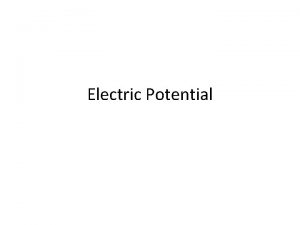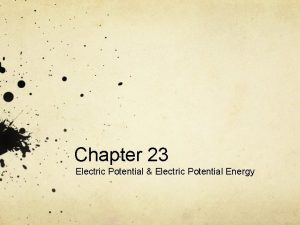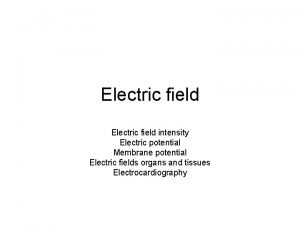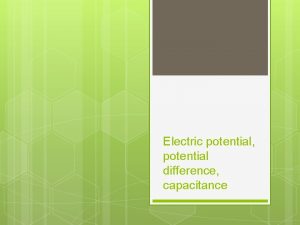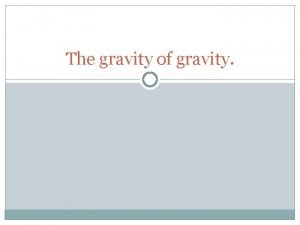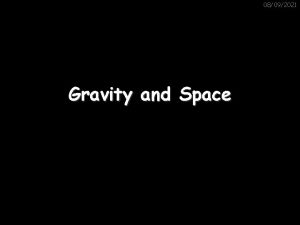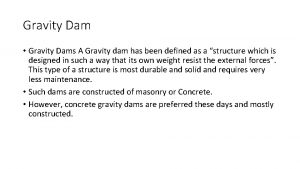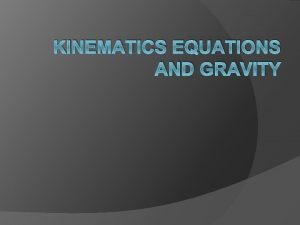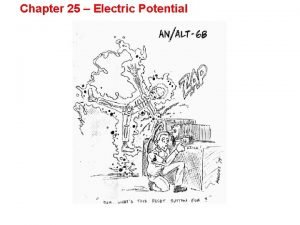Chapter 25 Electric Potential Electric Potential Like gravity



























- Slides: 27

Chapter 25 Electric Potential

Electric Potential Like gravity, the electric force is conservative: it has a Potential Energy. A charge in an electric field has electric potential energy (U) Example, a particle with charge +q in a constant EF: +q E F=q. E Introduction

Electric Potential Like gravity, the electric force is conservative: it has a Potential Energy. A charge in an electric field has electric potential energy (EPE, or U) Example, a particle with charge +q in a constant EF: Analogy: Gravity +q m E g F=q. E F=mg Introduction

Electric Potential Like gravity, the electric force is conservative: it has a Potential Energy. A charge in an electric field has electric potential energy (EPE, or U) For example, a particle with charge +q in a constant EF: Analogy: Gravity +q E m g F=q. E F=mg U=q. Eh U=mgh

Electric Potential The Potential energy DECREASES when the particle moves in the direction of the force for a conservative force, ΔU=-W (W=work done by the force). W > 0 when the particle moves in the direction of the force ΔU<0. Analogy: Gravity +q E m g F=q. E F=mg U=q. Eh U=mgh

Electric Potential The Potential energy DECREASES when the particle moves in the direction of the force for a conservative force, ΔU=-W (W=work done by the force). W > 0 when the particle moves in the direction of the force ΔU<0. +q A x E ΔU=-q. EΔx B

Example: +q moves from A to B A +q B Is ΔU<0, ΔU>0 or ΔU=0?

For a charge in an EF that is NOT constant, we calculate the energy by definition: A . q 0 ds B

Electric Potential For a charge q 0 in an external electric field: The potential energy per unit charge, U/qo, is the electric potential. § The potential is characteristic of the field only. § The potential energy is characteristic of the charge-field system. § The potential is independent of the value of qo. § The potential has a value at every point in an electric field. The electric potential is Section 25. 1

Electric Potential, cont. The potential is a scalar quantity. § Since energy is a scalar As a charged particle moves in an electric field, it will experience a change in potential. The infinitesimal displacement is interpreted as the displacement between two points in space rather than the displacement of a point charge. Section 25. 1

Electric Potential, final The difference in potential is the meaningful quantity. We often take the value of the potential to be zero at some convenient point in the field. Electric potential is a scalar characteristic of an electric field, independent of any charges that may be placed in the field. The potential difference between two points exists solely because of a source charge and depends on the source charge distribution. § For a potential energy to exist, there must be a system of two or more charges. § For the electric potential to exist, there must be a source charge. Section 25. 1

Work and Electric Potential UNITS: U/q=J/C=V (VOLT) § It takes one joule of work to move a 1 -coulomb charge through a potential difference of 1 volt. In addition, 1 N/C = 1 V/m Section 25. 1

Voltage Electric potential is described by many terms. The most common term is voltage. A voltage applied to a device or across a device is the same as the potential difference across the device. § The voltage is not something that moves through a device. Section 25. 1

Electron-Volts Another unit of energy that is commonly used in atomic and nuclear physics is the electron-volt. One electron-volt is defined as the energy a charge-field system gains or loses when a charge of magnitude e (an electron or a proton) is moved through a potential difference of 1 volt. § 1 e. V = 1. 60 x 10 -19 J Section 25. 1

Potential Difference in a Uniform Field The equations for electric potential between two points A and B can be simplified if the electric field is uniform: The displacement points from A to B and is parallel to the field lines. The negative sign indicates that the electric potential at point B is lower than at point A. § Electric field lines always point in the direction of decreasing electric potential. Section 25. 2

H L H L

More About Directions A system consisting of a positive charge and an electric field loses electric potential energy when the charge moves in the direction of the field. § An electric field does work on a positive charge when the charge moves in the direction of the electric field. The charged particle gains kinetic energy and the potential energy of the chargefield system decreases by an equal amount. § Another example of Conservation of Energy Section 25. 2

Directions, cont. If qo is negative: A system consisting of a negative charge and an electric field gains potential energy when the charge moves in the direction of the field. § In order for a negative charge to move in the direction of the field, an external agent must do positive work on the charge. Section 25. 2

Equipotentials Point B is at a lower potential than point A. Points B and C are at the same potential. § All points in a plane perpendicular to a uniform electric field are at the same electric potential. The name equipotential surface is given to any surface consisting of a continuous distribution of points having the same electric potential. Equipotential surfaces are perpendicular to the EF. Section 25. 2

A charge q in an EF has a force F=q. E applied and potential energy U=q. V. Charged Particle in a Uniform Field, Example A positive charge is released from rest and moves in the direction of the electric field. The change in potential is negative. The change in potential energy is negative. The force and acceleration are in the direction of the field. Conservation of Energy can be used to find its speed. Section 25. 2

Potential and Point Charges An isolated positive point charge produces a field directed radially outward. The potential difference between points A and B will be

Potential and Point Charges An isolated positive point charge produces a field directed radially outward. The potential difference between points A and B will be Calculation: Section 25. 3 C

Potential and Point Charges, cont. The electric potential is independent of the path between points A and B. It is customary to choose a reference potential of V = 0 at r. A = ∞. Then the potential due to a point charge at some point r is V q>0 V 0 q<0 r

Electric Potential with Multiple Charges The electric potential due to several point charges is the sum of the potentials due to each individual charge. § This is another example of the superposition principle. § The sum is the algebraic sum § V = 0 at r = ∞ V is the electric potential due to multiple sources. Section 25. 3

Potential Energy of Multiple Charges The potential energy of the system is . If the two charges are the same sign, U is positive and work must be done to bring the charges together. If the two charges have opposite signs, U is negative and work is done to move the charges apart. Section 25. 3

U with Multiple Charges, final If there are more than two charges, then find U for each pair of charges and add them. For three charges: § The result is independent of the order of the charges. Section 25. 3 For a system of many charges:

U with Multiple Charges, final If there are more than two charges, then find U for each pair of charges and add them. For a system of many charges: For three charges: § The result is independent of the order of the charges. WARNING: This is the potential energy of the pair, it is NOT the electric potential due to the charges. Section 25. 3
 Potential energy of an electric field
Potential energy of an electric field Equipotential lines
Equipotential lines Electric potential energy
Electric potential energy Electric potential inside non conducting sphere
Electric potential inside non conducting sphere Electric potential difference
Electric potential difference Pe=-qed
Pe=-qed Energy of electric field
Energy of electric field Electric potential electric field
Electric potential electric field Gravity for dummies and dummies for gravity equations
Gravity for dummies and dummies for gravity equations Chapter 33 conceptual physics
Chapter 33 conceptual physics Chapter 23 electric potential
Chapter 23 electric potential What is electrical potential
What is electrical potential Chapter 21 electric charge and electric field
Chapter 21 electric charge and electric field Chapter 21 electric charge and electric field
Chapter 21 electric charge and electric field K constant unit
K constant unit Chapter 21 electric charge and electric field
Chapter 21 electric charge and electric field How to find pressure potential
How to find pressure potential Osmotic potential
Osmotic potential How to calculate solute potential
How to calculate solute potential Neuronal pool
Neuronal pool Graded potential and action potential
Graded potential and action potential Action potential
Action potential Graded potential vs action potential
Graded potential vs action potential Refractory period in action potential
Refractory period in action potential Water potential
Water potential Source of bioelectric potential is dash in nature
Source of bioelectric potential is dash in nature Transmission across a synapse
Transmission across a synapse Suggmadex
Suggmadex










